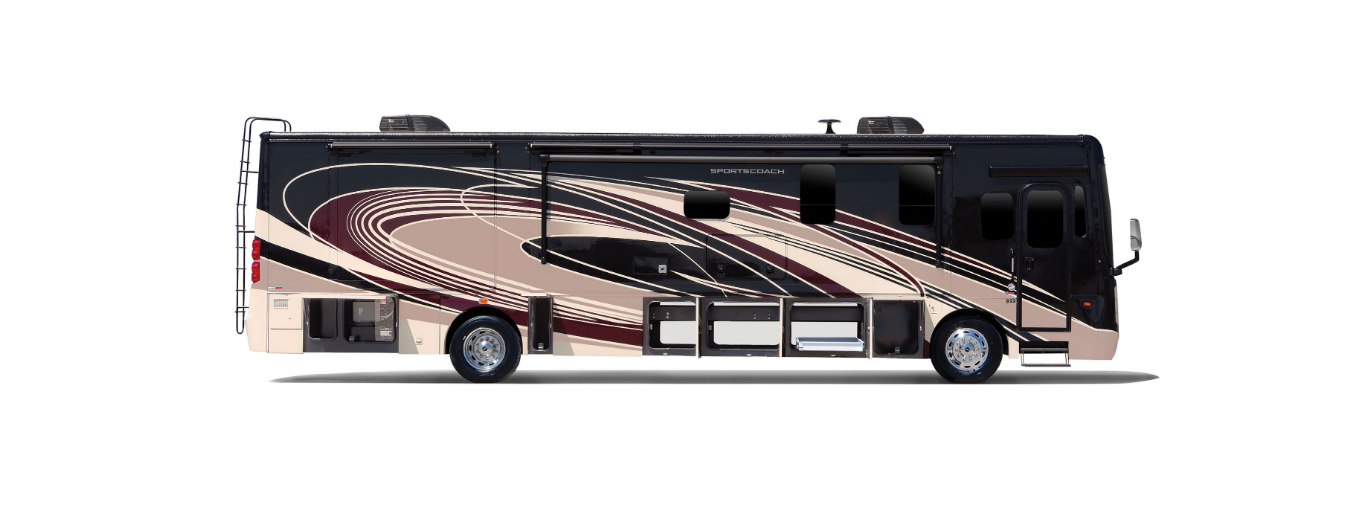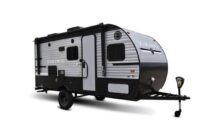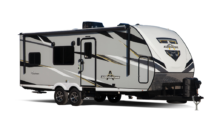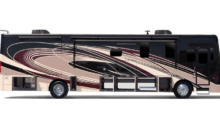2022 Coachman Sportscoach CLASS A DIESEL MOTORHOMES Waste Water System Owners Manual




2022 Coachman Sportscoach CLASS A DIESEL MOTORHOMES Waste Water System


WASTE WATER GENERAL INFORMATION
The waste water system in your RV can be described as two separate systems. A gray water system, which consists of the drain lines and holding tank for waste water from the sinks and tub, and a black water system, which includes the holding tank and drain for toilet wastes. Each system is self-contained and allows disposal of waste water at designated dump stations at your convenience. Due to the vast array of floor plans and the necessary rearranging of plumbing systems, locations will alter, but in general, the holding tanks are located approximately beneath the bathroom and kitchen areas. Drain valves and drain hose storage are usually located on the driver’s or off-door side of the unit.
UNPLEASANT ODORS
Components of the gray water system have drain traps and all tanks are vented to equalize air pressure and disperse odors to the outside.NOTICE
At times, the rocking movement of the coach while driving may empty the drain traps of their water and allow odors from the gray water tank(s) to enter the RV. To solve this problem, simply pour 2 cups of water down the drain to refill the drain trap. Residue in the drain water lines and black waste tank can also produce odors. To combat water holding tank odors, an RV approved deodorizing agent should be used. An agent that dissolves grease and fats and contains a detergent will help keep the tanks and lines clean and free flowing. You can obtain the deodorizer at most campgrounds and at stores that carry camping supplies.
EMPTYING THE HOLDING TANKS
Each holding tank has a drain line and dump valve, which permits dumping tanks individually or together. Each tank should be emptied often and ONLY at dump stations designated for this purpose. Dump stations can be found at most campgrounds and truck stops. Many service stations, particularly along interstate highways, also have these facilities. Campground directories list dumping station locations across the nation. If possible, dump holding tanks before a trip to reduce the gross vehicle weight. It is very important that you keep enough water in the black water tank to cover the bottom to prevent hardening of any waste residue that may remain. Never dump the black water tank until it is 3/4 full. (Check the tank level on your monitor panel.) This practice ensures that enough water is in the tank to flush all wastes into the sewer line. If necessary, fill the tank to the 3/4 mark with additional water before draining. Never put anything in the holding tanks other than normal drain water, body waste, and biodegradable products. Paper wrappers, gum, cigarettes, etc., no matter how small, should NEVER be placed into either the gray or black tanks as doing so could cause damage to your plumbing system and/or tanks.If connecting to a campsite dump station sewer inlet
- DO NOT open termination valves until tanks are 3/4 full.
- DO NOT keep black water valve open while parked.
To empty your holding tanks:
- Make sure all sewer drain tank valves are CLOSED before removing the RV drain cap.
- Remove the cap from the RV drain termination and connect the sewer drain hose.
- Attach the other end of the flexible sewer drain hose to the dump station inlet. Be sure both ends of the flexible sewer drain hose are securely attached.
- Drain the black water tank first by pulling the termination valve handle away from the valve body to the OPEN position. Be sure to allow sufficient time for the tank to completely drain.
- Rinse the tank with several gallons of water by depressing the stool pedal, hand flush handle, or use the black tank flush if equipped. CLOSE the valve on the stool and let it fill before releasing to the tank. This creates additional force to flush the tank more completely.
- Drain the gray water tank by pulling the termination valve handle away from the valve body to the OPEN position. Draining the gray tank last uses the water in the tank to rinse the drain lines and flexible sewer drain hose.
- When the tanks are empty, starting at the RV’s termination, “lift and walk” the remaining water out of the drain hose toward the dump station inlet.
- CLOSE all of the termination valves by pushing the handles back to the closed positions.
- Remove the flexible sewer drain hose from the RV drain termination and wash it thoroughly with clean water. Remove the other end from the dump station inlet and replace it in its storage compartment.
- Secure the sewer hose storage cover.
- Replace the caps on both the RV outlet and the dump station inlet.
- NEVER empty your holding tanks directly on the ground, a roadway, river, or stream.
- ALWAYS clean up the dump site before leaving.
NOTICE
If your RV has a Macerator System, the steps for emptying your holding tanks will vary. Please refer to the Macerator System section for complete instructions .Solid waste often will not flush directly into the sewer system. Liquid waste typically drains the best. Therefore, you must allow water to accumulate in the black tank and give the chemicals time to break down the solids before emptying the tank. Always keep enough water in the waste tank to cover the bottom. Doing so will help prevent waste from solidifying, which will prevent the waste from being flushed from the system. If draining the gray water tank directly into the sewer inlet while parked, be sure to close the termination valve for a period of time before leaving, allowing water to accumulate in the tank for use in flushing the drain line and flexible hose.
CAUTION
Keep drain valve closed to minimize the presence of sewer gases. Sewer gases can be present when RV is connected to campground sewage hookup. May lead to illness or personal injury.
GUIDELINES FOR TROUBLE-FREE OPERATION
- NEVER put anything in a black water tank other than biodegradable RV toilet paper. You can find biodegradable paper products at most stores that sell camping supplies and at campgrounds that have a store on the premises. You can also use RV Waste Tank Chemical solutions for deposit into the waste tanks if you prefer.
- Do NOT put automotive antifreeze, household toilet cleaners, household drain cleaners, or any solid material into the wastewater system.
- ALWAYS use chemicals in the black water system made especially for this purpose.
- When cleaning components of the wastewater system, use ONLY cleaners made for RV systems.
- ALWAYS keep the drain cap in place and termination valves closed.
- After every third time the holding tanks are emptied, fill and flush both tanks with clean, fresh water a couple of times to keep them clear and clean.
- It is important to note that harmful and toxic materials can accumulate if the holding tanks are not regularly drained and thoroughly rinsed. It is also important to use holding tank deodorizing and cleaning agents in the wastewater tanks to reduce odors and keep the lines open and free-flowing.
- Keeping the tanks and level gauges clean allows the monitor panel to accurately assess the status of the tank.
NOTICE
Remove the waterless trap before using mechanical drain-cleaning devices. The waterless trap can be damaged.
BASIC TROUBLESHOOTING TIPS
Black tank will not drain:
- Check termination valve for proper operation.
- The buildup of waste debris in the tank. Add water to assist in flushing the tank or utilize Black Tank Flush if equipped.
- The buildup of tissue in the tank. Use black tank chemicals to break down wastes.
- Always use a minimum amount of biodegradable toilet paper.
- Always use plenty of water when flushing.
HEATING PADS
The holding tanks on your recreational vehicle, if equipped, are heated with a 12VDC heating pad to prevent freeze-ups during cold weather. These pads monitor and maintain the holding tank fluids once powered ON with the switch typically found in the RV’s control panel. The built-in sensor in the heat pad, when the switch is in the ON position, will activate the tank heater as soon as the contents in the tank drop to an approximate temperature of 45°F. When the liquid within the holding tank is heated and rises to approximately 64°F, the tank heater will automatically deactivate, awaiting the fluids to again drop to 45°F and repeat the cycle. If the ambient outside temperature rises and remains above freezing, or when the tanks are empty, switch the power to OFF.
NOTICE
Fluids must be present inside the holding tank for the tank heaters to properly function.
Recent Posts
VW Jetta Engine Fuse Box Diagram
Access the comprehensive 2010-2018 VW Jetta Passenger Fuse Box Diagram to troubleshoot electrical issues effectively.…
VW Jetta Passenger Fuse Box Diagram
Explore the comprehensive VW Jetta Passenger Fuse Box Diagram to troubleshoot electrical issues effectively. Understand…
2023 Ford F-150 Lightning Fuse Box Diagram
Under Hood Fuse Box Location Remove the front luggage compartment cover. Under Hood Fuse Box…
2022 Kawasaki NINJA H2 SX SE Brake Lever Adjuster Owner’s Manual
2022 Kawasaki NINJA H2 SX SE Brake Lever Adjuster Owner's Manual NOTICE Only adjust the front…
2023 Land Rover Range Rover Evoque Exiting The Vehicle Owners Manual
2023 Land Rover Range Rover Evoque Exiting The Vehicle SINGLE LOCKING WARNING Before exiting the…
2023 Land Rover Range Rover Evoque Front Seats Owners Manual
2023 Land Rover Range Rover Evoque Front Seats FRONT SEAT SAFETY Make sure to read…




